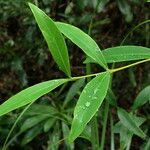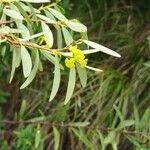Shrub 0.3–2 (–4) m high; young stems with minute hairs. Leaves opposite, glabrous; petiole 1–3 (–9) mm long; lamina narrowly elliptic to elliptic, oblong-elliptic or ovate, 9–80 mm long, 5–30 mm wide, cuneate to obtuse or rounded at base, acute to obtuse at apex, discolorous (green and glossy above, pale glaucous-green and dull below), venation obscure. Inflorescence of few-to many-flowered terminal racemes; racemes condensed or elongate; rachis to 30 mm long in fruit; peduncle 1.5–22 mm long. Flowers bisexual, to 10 mm long, sparsely hairy outside, glabrous inside, green or greenish yellow (to white); pedicel c. 1 mm long, articulate at or near base. Hypanthium c. 4–8 mm long, splitting irregularly at base in fruit. Sepals ovate-oblong, (1–) 1.5–2 mm long. Upper stamens semi-exserted; lower stamens included. Mature fruit naked, ellipsoid or ovoid, 5–8 mm long, fleshy, red.
Shrubs 0.5-2 m or more tall. Branches reddish brown, glabrous. Leaves opposite; petiole ca. 1 mm; leaf blade reddish brown on both surfaces when dried, obovate, elliptic-oblong, or lanceolate, 2-5 × 0.5-1.5 cm, papery to thinly leathery, both surfaces glabrous, base broadly or narrowly cuneate, apex obtuse or acute; lateral veins dense, slender, at narrow angle to midrib. Inflorescences terminal, capitate, several flowered; peduncle 0.5-1 cm, glabrous. Pedicel 1-2 mm. Calyx yellowish green, 7-12 mm, exterior glabrescent; lobes 4, broadly ovate to oblong, ca. 3 mm, apex acute or obtuse. Stamens 8. Disk scales often 2 or 4. Ovary obovoid or ellipsoid, glabrous or apex sparsely pubescent; style very short; stigma capitate. Drupe red to dark purple, ellipsoid, 7-8 mm. Fl. and fr. summer-autumn.
A shrub or small tree. It grows 1.5 m high and spreads 0.9 m wide. The leaves are oval and 6 cm long. The flowers are white, cream or greenish and in heads at the ends of the branches. The fruit are red to dark purple and 7-8 mm across.



